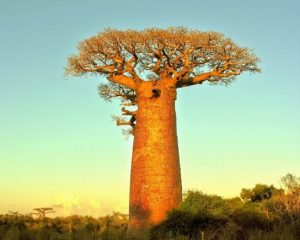
If climate change persists at its current rate, then many animals will lose their homes, including that of the beloved Lion King mandrill, Rafikis’; the most recognisable silhouette of a tree ever seen. The iconic baobab tree, famous for its resemblance of an upside down tree, is under threat. In an arid, scrubland environment this species acts as a fundamental source of water, food and shelter for many animals, including the endemic lemurs of Madagascar.
Since travelling to South Africa at the age of nine, I remember many animals, but the only plant I can name and recognise is a baobab. With their thick, tall, bare trunks and root like branches, they are unlike any other plant. They don’t just possess an aesthetic appeal but are highly beneficial to biodiversity and the local and international community. Baobab fruit is highly nutritious, with its powder being rich in Vitamin C; perfect for anyone who is looking for a solution to wrinkles (well supposedly) (Schumann et al., 2012). In addition, it provides food, medicine, fibre, craft material and income to the local community in Africa (Sanchez, 2012). One potential use of the baobab tree is as a biofuel. This has already been tested with success and is shown to meet European and American biodiesel standards (Modiba et al., 2014).
So, baobab is a plant providing many benefits to people, with the potential to reduce fossil fuel use if it becomes commercially viable as a biofuel. What is the problem?
Two words…CLIMATE CHANGE!

Due to longer periods of drought from a slight increase in temperature and increasingly infrequent rainfalls, seedling establishment is poor, resulting in low recruitment rates (Venter & Witkowski, 2013). Through the last 25 years of the 20th century, annual rainfall decreased by 1.5%, suggesting that future desertification throughout Africa is inevitable. This places more pressure on seedling settlement and potentially the future population (Geist & Lambin, 2004). Once mature baobabs can withstand prolonged drought, with incredible water storage capabilities within their swollen bellied trunk. Seedlings, however do not have this quality. So to overcome the negative impact caused by climate change, human interference may be necessary. Furthermore, mature trees are beginning to show symptoms of disease and therefore there is a greater reliance on recruitment, which has already appeared under pressure.
Many conservation efforts have already taken place but are they actually conserving trees for the future? Researchers have discovered, via spatial distribution modelling, that only a very low percentage of the present distribution is predicted to remain a suitable habitat for the baobab in the future (Sanchez et al., 2011). As a result of this shift in distribution, the present protected areas are unlikely to actually impact the future population. Therefore, we are wasting our energy on lost causes, where instead it should be focused at future locations (Vieilledent et al., 2013).
The true potential of the baobab is finally being realised, but is it too late? Fingers crossed it is not.
References
Geist, H. & Lambin, E., (2004), “Dynamic Causal Patterns of Desertification”, BioScience, Vol. 54, No. 9, pp: 817-829
Modiba, E., Osifo, P. & Rutto, H., (2014), “Biodiesel production from baobab (Adansonia digitata L.) seed kernel oil and its fuel properties”, Industrial Crops and Products, Vol. 59, No. n/a, pp: 50-54
Sanchez, A, C., (2012), “The status of baobab tree populations in southern Malawi: implications for further exploitation”, Forests, Trees and Livelihoods, Vol. 20, No. 2-3, pp: 157-173
Sanchez, A, C., Osbourne, P. & Haq, N., (2011), “Climate change and the African baobab (Adansonia digitata L.): the need for better conservation strategies”, African Journal of Ecology, Vol. 49, No. 2, pp: 234-245
Schumann, K., Wittig, R., Thiombiano, A., Becker, U. & Hahn, K., (2012), “Uses, management, and population status of the baobab in eastern Burkina Faso”, Agroforestry Systems, Vol. 85, No. 2, pp: 263-278
Venter, S, M. & Witkowski, E, T, F., (2013), “Where are the young baobabs? Factors affecting regeneration of Adansonia digitata L. in a communally managed region of southern Africa”, Journal of Arid Environments, Vol. 92, No. n/a, pp: 1-13
Vieilledent, G., Cornu, C., Sanchez, A, C., Pock-Tsy, J. & Danthu, P., (2013), “Vulnerability of baobab species to climate change and effectiveness of the protected area network in Madagascar: Towards new conservation priorities”, Biological Conservation, Vol. 166, No. n/a, pp: 11-22
Word count: 493
Recent Comments